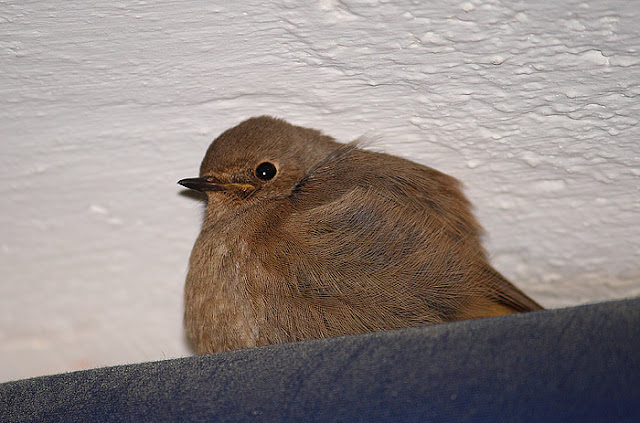I usually put a plate with grains and some water for collared doves and any other feathered friend, so I saw this cutie leap across the terrace during the day, trying to snatch some leftovers between the dove raids. My guess is that we owe the honour of the bird’s visits not to the fact that it (I don’t like using “it” for animals, but in this case I just don’t know its sex) especially enjoys our company (much as it would flatter me), but rather to the brilliant strategy this smart feathered creature worked out to avoid competing with doves for grain by day: to stay overnight and be the first to get to the birdfeeder at dawn (just like humans queuing up early for Christmas sales or concert tickets).
Surprisingly, it wasn’t at all bothered by either the activity on the terrace or my camera flash at close range.
.jpg) |
| Common Nightingale (Luscinia megarhynchos) fluffed up (© 2013 LightColourShade. All rights reserved) |
The Common Nightingale or simply Nightingale (Luscinia megarhynchos), aka Rufous Nightingale, is a small passerine bird, generally considered to be an Old World flycatcher, Muscicapidae. It is a migratory insectivorous species breeding in forest and scrub in Europe and south-west Asia, and wintering in southern Africa (luckily, local nightingales don’t think such a long journey is worth their while).
| Common Nightingale (Luscinia megarhynchos) perched between the ceiling and rolled-up parasol (© 2013 LightColourShade. All rights reserved) |
+perched+under+the+ceiling.jpg) |
| Common Nightingale (Luscinia megarhynchos) perched under the ceiling (© 2013 LightColourShade. All rights reserved) |
+under+the+ceiling.jpg) |
| Common Nightingale (Luscinia megarhynchos) under the ceiling (© 2013 LightColourShade. All rights reserved) |
You know, I've never even seen a nightingale, though I've heard of them so often in literature (and music). As usual, a wonderful little post!
ReplyDeleteActually, that's the first time I managed to see the songbird close up, usually I just hear them sing. Since it's one of the Old World Flycatchers this bird found naturally in the Americas, so I'm glad you made your first contact with this wonderful bird through my post.;)
DeleteI don't think this a Nightingale. I think it might be a young Common Redstart personally.
ReplyDeleteYou can just about see the slight reddish colour under the tail in your photos as well.
ReplyDeleteYou're wrong on this one: I did a lot of research to identify the bird and made sure I didn't mix it up precisely with redstarts which are also found here. Nightingale is plain brown above except for the reddish tail (the reddish colour under the tail you noticed. BTW, thanks for taking such a close look at my pictures -- I feel flattered), it's buff to white below, although it looks darker on the pictures due to the lighting.
DeleteRedstarts have much brighter orange-red frequently quivered tails, from which they get their names ("start" is an old word for "tail"). Among common European birds, only Common Redstart and the Black Redstart (Phoenicurus ochrurus) have this tail colour.
Lovely guest :) but it is not a nightingale but a female black redstart. :)
ReplyDeleteThanks for commenting. At this point I'm not sure about this one myself, but I'm going to post photos of a bird I think is indeed a Common Redstart. ;) Stay tuned.
ReplyDelete